Below we share 5 stretches that will revitalize your posture in times like these when you spend the whole day working from home.
Working from home has very interesting benefits: there are more freedom and flexibility to manage your own schedule, no time wasted in commuting, some can dress more comfortably… But it also has its disadvantages: some people don’t have their the ergonomic equipment they left at the office. No adapted chair, no adjustable screen, sometimes not even a suitable desk…
We sit all day, more or less comfortably, at best on a classic office chair, at worst slumped on the sofa. This is terrible for our posture and for the musculoskeletal balance, especially when one does not leave the house for the whole day, for weeks. The good news is that it is possible to compensate for this bad posture by practicing certain stretches regularly throughout the day.
1 – The “Upside Down Dog”: Stretching Of The Posterior Spine
When we sit badly for a whole day we end up with the muscles of the posterior chain of the legs (hamstrings in particular) permanently shortened. And with the lumbar area constantly flexed, this stretch works great at softening back pain.
Stretching and loosening the posterior chain of your legs will help soften this pain. And for this, the yoga position of the “upside-down dog” is particularly recommended.
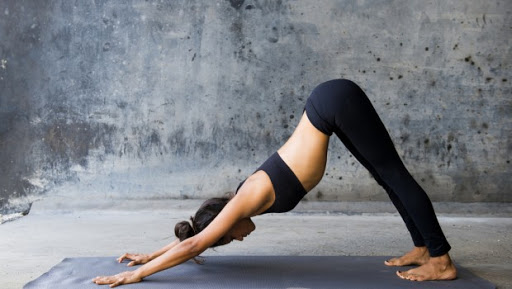
The goal is that the body forms a 90º angle at the level of the hips while your keep your the hands and feet on the ground. The arms should remain in line with the backline, the legs practically stretched and there should be a stretch in the back of the thighs and in the calves. Try to gradually bring your heels closer to the ground while keeping the lumbar arch and trying to pull your glutes towards the ceiling.
This should be done several times during the day to physically reactivate a little. Stay in the position 30 seconds to 1 minute and make sure you keep an active posture.
2 – “Figure 4”: Stretching The Glutes And The Pyramidal Muscle
Frequently, the sitting position also causes chronic tension in the gluteal muscles and in particular, in the pyramidal muscle, a small muscle located under the gluteus maximus.
This is particularly the case when we tend to sit asymmetrically, on a single buttock for example. Ultimately, this can cause a misalignment of the femur bone which is no longer properly placed at the hip point and cause hip pain, even in the knee or lower back. To soften this muscle, the stretch in Figure 4 or stretch in 4 is particularly effective.
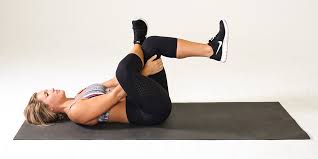
Sitting on your back, place your right ankle on the left knee and lift your left leg (flexed) so that your leg is perpendicular to your pelvis. Keep your lower back straight, preferably flat on the floor. You should feel a stretch in the side of your buttocks.
Again, stay in position 30 seconds to 1 minute and change legs. Stretching can also be done while seated.
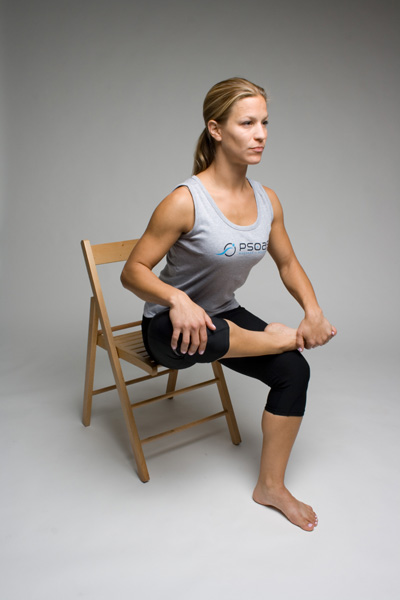
3 – Stretching Of The Hip Flexors
To go around the hip muscles, we must also look at the flexors: the famous psoas. These long muscles attached to the iliac crest up to the legs have the role of bending your legs, for example during knee ascents. By being constantly in a shortened position while sitting, they tend to stiffen and this can create tension on the positioning of the pelvis and lower back.
To stretch your right psoas you have to make a kind of lunge, knee straight on the ground and try to lower your pelvis towards the ground gradually while keeping your right gluteus contracted – keep the pelvis in a neutral position and avoid going into anteversion.
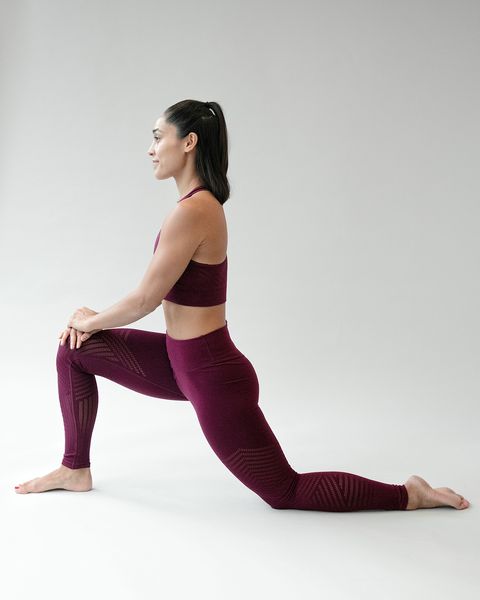
This position should cause a stretch in the front of the thigh, at the insertion of the hip. Again, stay in the position for 30 seconds to 1 minute, remaining well sheathed in the buttocks and abdomen to ensure an optimal position.
4 – The “Doorway Stretch”: Stretching The Pectorals
In a sitting position, and all the more so if you are at home, improperly installed or even on a sofa, you tend to arch your chest. In this position, the muscles in the front of the torso (pectorals, anterior deltoids, biceps) are permanently contracted and shortened. Therefore, they might tend to stiffen.
It is therefore important to get up frequently and stretch while arching your upper back a little. An effective way to avoid the tensions in these muscles is to stretch them using the “doorway stretch”.
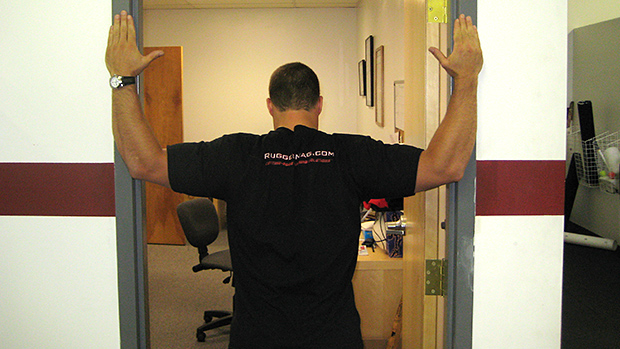
The principle is simple: place your forearms vertically against the edges of a doorstep and cover your back muscles so that your shoulders remain compact. In this position, move forward gradually until you feel a stretch in your pectorals (chest muscles) or even in the front of the shoulders at the insertion of the biceps.
Go slowly so you don’t put too much tension on this fragile area on the front of the shoulders. Take deep breaths, taking care to keep your abs tight (remember to consciously lower your ribs to contract the abdominal muscles). Small pectoral, large pectoral, anterior deltoids: all the muscles in the front of the torso will be stretched! Again, about 1 minute of stretching several times a day is ideal!
5 – The Shoulder Extension
In the same way, to stretch the front of your shoulders even more you can work on extending them.
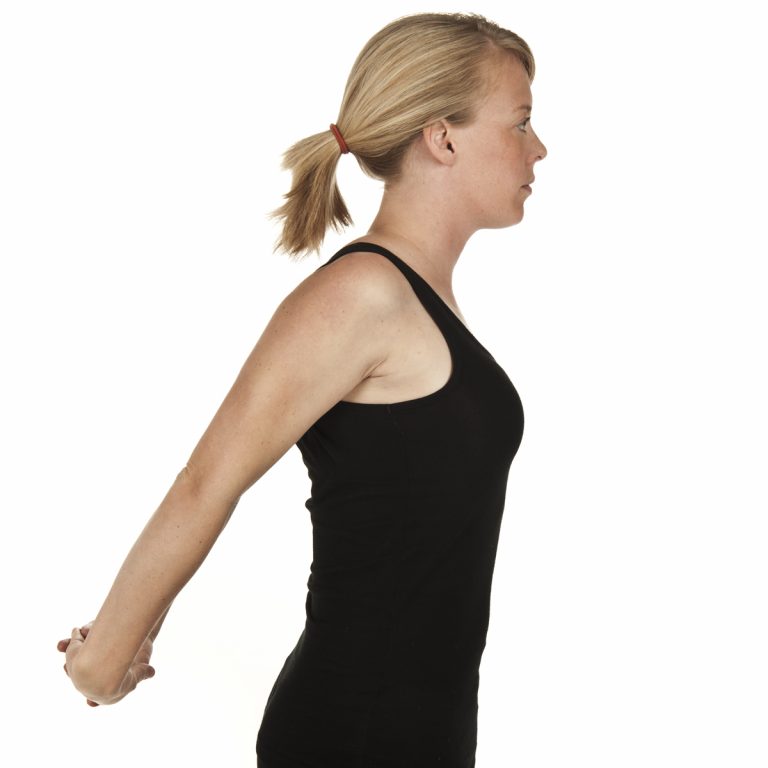
Doing this is quite simple: place your two hands behind your back, grip your fingers and try to raise your arms backward, keeping the bulging torso. You should feel a stretching sensation in the front of your shoulders. Keep this position for 30 seconds to 1 minute, taking care not to “roll” your shoulders forward, and keep them well retracted back: hence the importance of keeping the torso bulged.
This movement can also be performed seated, with care, using the ground. It should look something like this:
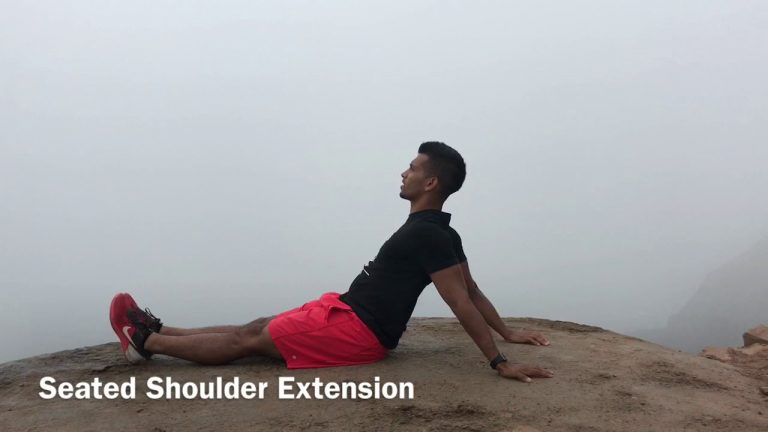
[Photo by Morgan Petroski on Unsplash]

